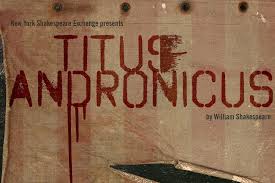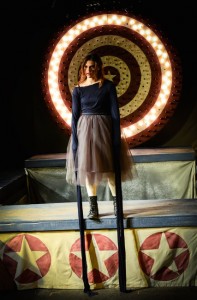 During a great pre-show conversation with me and some of my students, director Ross Williams emphasized that his New York Shakespeare Exchange production of Titus Andronicus would be relatively low on stage blood. He talked about wanting to distinguish his production from some others — he mentioned the 2011 production at the PublicLab, and I wonder if he was also thinking about the intensely wet glory of this past fall’s Tamburlaine the Great — and also about his desire to have the language be heard. After the talk but before the show, a student admitted to me that she had been hoping for gore. The full spectacle was what she’d come down to Soho for on a cold February night. There were no red liquids until just before intermission — but I’m pretty sure she got what she wanted.
During a great pre-show conversation with me and some of my students, director Ross Williams emphasized that his New York Shakespeare Exchange production of Titus Andronicus would be relatively low on stage blood. He talked about wanting to distinguish his production from some others — he mentioned the 2011 production at the PublicLab, and I wonder if he was also thinking about the intensely wet glory of this past fall’s Tamburlaine the Great — and also about his desire to have the language be heard. After the talk but before the show, a student admitted to me that she had been hoping for gore. The full spectacle was what she’d come down to Soho for on a cold February night. There were no red liquids until just before intermission — but I’m pretty sure she got what she wanted.
The Times review crowed that the show was “electric.” I’ll happily concur. The energy started with what, in retrospect, remains my favorite scene, a dumb-show bloodless bloodletting induction, in which all the characters appeared together before the action started and melodramatically cut each others’ throats. No language yet, and no blood, just great movement and the first appearance of a very effective audio prop, a pull-operated old-fashioned grain dispenser, which poured what I think were kernels of unpopped popcorn into an aluminum tub each time a character was killed or assaulted. Over the course of the full play, that’s a lot of corn flowing into the basin — and the repeated rain-like sound made a kind of refrain throughout the evening.
The other great innovation of this production was the prominence of the Clown, played by Kerry Kastin with a bow-tie and white face-paint. As the Times review emphasized, the Clown showed up to play the roles of the (many) characters who appeared on stage to be killed. Starting with a pair of sons in the opening scene — Tamora’s Alarbus, whose limbs are lopped to appease the spirits of dead Roman soldiers, and Titus’s Mutius, who dies defending his sister from his enraged father — the Clown’s part formed a visual counterpoint of brightly-colored doom. I loved Kastin’s performance, and in a way I thought she made theatrically visible one of the things we Shakespeare scholars tend to say about this play, that’s it’s half dark comedy, riffing off of Marlowe’s bloody hero-villians (including Tamburlaine). Combined with restraint in the use of blood, the Clown’s smiles and the sounds of circus music, mostly after intermission, brought out the aesthetic beauty of the verse and the symbolic force of spectacle. This Rome is, as Titus calls it, “a wilderness of tigers,” but we the audience loved watching it.
I thought Terence MacSweeny’s Marcus gave the strongest readings of the language, but the towering center of the play was Brendan Averett’s Titus. I’d seen him before as the tallest and slowest of the mechanicals in Julie Taymor’s Midsummer Night’s Dream in Brooklyn, and in a few moments, especially early in the play, some of the sleepiness of that performance clung to him. After losing his hand and the heads of two more sons just before intermission, however, he surged into madness. Dressed “like a cook” in the final scene, delicately spooning out what looked like raspberries to Tamora and Saturninus, he dominated the second half of the play with wayward intensity.
My (predictably) favorite speech in the play has the tormented hero imagining himself and his mutilated daughter as ocean and sky, raging into violent contact:
And wilt thou have a reason for this coil?
I am the sea. Hark how her sighs doth blow.
She is the weeping welkin, I the earth,
Then must my sea be moved with her sighs… (3.1.225-8)
I didn’t quote this passage in my book on Shakespeare’s Ocean, but I think I’ll want to dig into the violent ecological imagery in this play at some point. The sea-sky-earth system in Titus is self-consuming rather than sustaining. In perhaps the most notorious mismash of comic bluster and horrific violence, when Titus bakes Tamora’s cruel sons into pies that he’ll later serve to their mother, he imagines that when the Queen eats her children, she follows Nature’s pattern:
Like to the earth [she will] swallow her own increase (5.2.191).
It’s a play full of child-killing, and particularly of parents who destroy their own children, from its first to last scenes. Shakespeare’s portrayal of Roman and Gothic warrior cultures that send the young off to die resonates uncomfortably with the rise of militarism in 21c American culture. (The archery scene was played with paper airplanes, but I thought about “American Sniper.”)
The play also exposes popular entertainment’s interest in sexualized violence, and Kate Lydic’s Lavinia, perhaps the only straightforwardly sympathetic figure in the play, mutely bore witness to the cost of building cultural values through violence against women. Lydic’s speaking performance was powerful, especially when she appealed to Tamora to save her from the Goth Queen’s lustful sons. When she returned mute after their attack, her hands covered with stocking-stumps and her mouth permanently closed, her presence created a kind of counter-Clown on stage, recalling the tragic loss that offsets the comic play.
It’s hard, after so many deaths, including this production’s extra dozen-plus in the silent Goth War opening, for another stage killing to shock. But when old Andronicus took the advice of the bad emperor Saturninus, filtered through the morally fraught example of Livy’s Virginius, to kill his beloved daughter, the play’s balance shifted for the last time. Titus himself had been playing something like the Clown’s part, spooning out bits of raspberry-flavored child flesh to the imperial couple, but in killing Lavinia he tipped back into pure madness.
I drove home on frozen highways and through a maze of road construction in the Bronx thinking about cultures that write their own violence onto the bodies of their children, and about how this play engages these dark questions with parodic and disturbing touches. I was also thinking about the Super Bowl — but maybe that’s another post.
Go see the show before it closes this Sunday!



[…] as fast as they could — Iago turned. I thought of Tamora, Queen of the Goths in Titus, which I saw with my students this past winter. I wondered about the gendered conventions of stage villainy. Is it sexist to find a female Iago […]